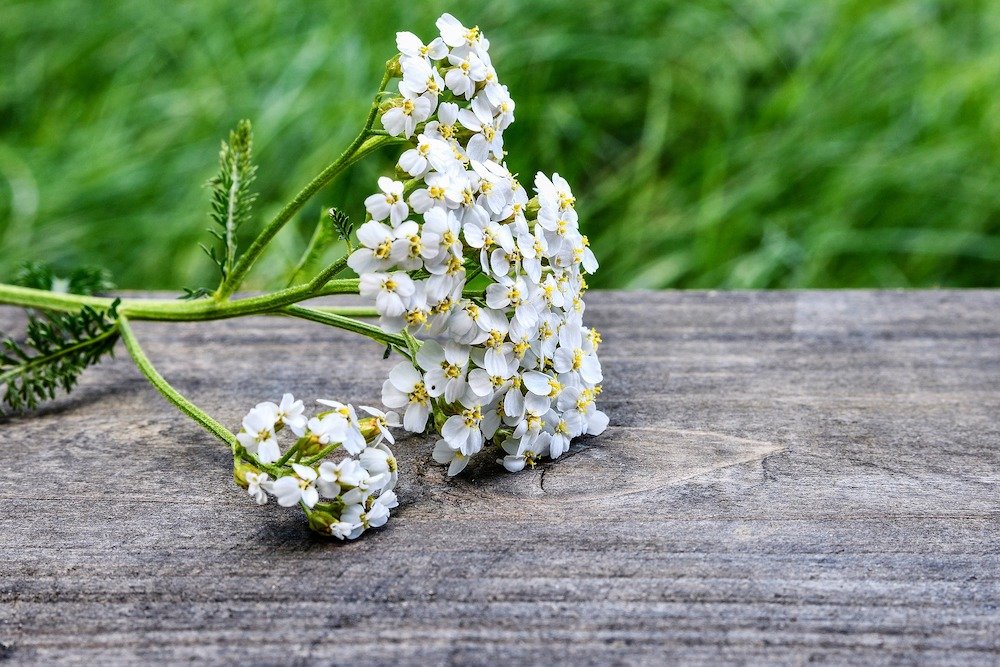Yarrow

Yarrow (Achillea millefolium) is a commonly found plant that is generally viewed as a weed. However, in folk medicine it has long been an important medicinal plant. Yarrow's essential oils, bitter substances and tannins aid in treating digestive problems, stimulate the appetite, stabilise gut bacteria and have a positive effect on blood circulation.
The name "yarrow" is given to a number of very similar Asteraceae varieties and subspecies of Achillea millefolium.
The most well-known variety is common yarrow, which is found in meadows, pastures, fallow areas and along paths. This wide-rooting hardy perennial can grow in almost any climate and soil, thus allowing it almost cosmopolitan (global) distribution. Its narrow, typically pinnate leaves grow from coarse stems and can be eaten as a wild herb until flowering; in older stages they taste bitter.
From the end of May until mid-October, the plant displays capitulum flowers, mostly white but sometimes also pink, in cymes standing together like umbels with a pleasant, spicy-sweet scent.
One subspecies is the bright pink flowering Achillea millefolium subsp. Sudetica, which grows at high elevations and contains different substances than common yarrow.
A "weed" as medicinal plant
Yarrow has long been used in natural medicine. Its many names – including herbe militaris, staunchweed, nosebleed, arrowroot, and sanguinary – speak to its importance for treating wounds. Its botanical name Achillea refers to the mythical Greek hero Achilles, who is said to have used yarrow to treat wounded warriors. Yarrow's blood-staunching effect and ability to hasten the healing of wounds earned it the name "soldier's woundwort".
Later, its young leaves or extracts were valued for their strong blood-purifying properties and were used to strengthen the circulatory system.
The name "yarrow" probably derives from the Middle High German word garwe, which roughly means "to heal", from which it can be concluded that shepherds administered the herb to ailing sheep who gladly ate it. Horses generally do not eat yarrow growing in pastures, but they do like the herb when it is dried.
The above-ground parts (Millefolii herba) and flowers (Millefolii flos) are used for medicinal purposes. The parts of the plant are dried or pressed to make herbal liquids. The best harvest time is in summer when the plants are in full flower – the essential oils in all parts of the plant are said to be at their most potent in the noonday heat.
What substances are found in yarrow?
Officinal yarrow contains at least 0.20% essential oil and 0.02% proazulenes. It also contains a number of flavonoids, bitter substances and tannins.
The essential oil in yarrow may contain – depending on the species – a large number of monoterpenes (scents and flavours), including pinenes, which give the plant its strong aroma, and camphor. The highest amounts of essential oils are found in the flowers.
The proazulenes in yarrow are further aromatic components of the essential oil. These are precursors of the active substance chamazulene, which is obtained by distillation from true camomile in particular, and has a characteristic deep blue colour.
What does yarrow do and for what is it used?
- Yarrow is used to treat loss of appetite and digestive problems due to its stimulating and digestion promoting effects. Its bitter substances directly affect the taste receptors and increase formation of saliva and gastric juices. It also stimulates the formation of bile. Yarrow's tannins form a protective film on mucosal surfaces, helping to prevent further irritations.
- Yarrow inhibits the growth of harmful bacteria and has a calming and antispasmodic effect on gastrointestinal ailments like bloating and mild cramping.
- Yarrow has a strengthening effect on the cardiovascular system.
- Yarrow preparations applied externally help to treat inflammations and edemas. The essential oils and proazulenes have anti-bacterial, anti-inflammatory and detumescent effects. A formula from earlier times for preventing cracked heel consisted of a poultice of yarrow and loam.
Yarrow's effectiveness can be enhanced by combining it with the closely related true camomile and peppermint.
Adverse effects
Some species of Achillea may cause allergic reactions with rashes and itching.
Caution: Do not feed yarrow to animals with Asteraceae allergies!
Sources and further reading:
- Heßel, M. (03 2013). Mein Tierheilpraktiker. Von Heilpflanze Schafgarbe: https://www.tierheilpraktiker.de/mein-tierheilpraktiker/alle-ausgaben/3-2013/164-heilpflanze-schafgarbe.html abgerufen
- Länger, R., & Kupelka, W. (2001/2002). Schafgarbenkraut. Phytokodex. Von https://www.kup.at/db/phytokodex/datenblatt/Schafgarbenkraut.html abgerufen
- Prentner, A. (2017). Heilpflanzen der traditionellen europäischen Medizin. Wirkung und Anwendung nach häufigen Indikationen. . Wien: Springer Verlag.
- Purle, T. (05. 05 2020). Kräuterbuch.de. Von Schafgarbe: https://www.kraeuter-buch.de/kraeuter/Schafgarbe.html abgerufen
- Reichling, J., Gachnian-Mirtscheva, R., Frater-Schröder, M., Di Carlo, A., & Widmaier, W. (2008). Heilpflanzenkunde für die Veterinärpraxis. Berlin-Heidelberg: Springer Medizin Verlag













